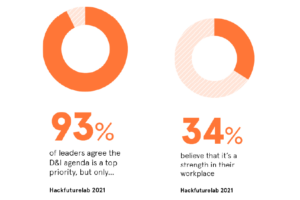
Driving genuine diversity & inclusion: The problem with unconscious bias training
September 3, 2021
Driving genuine diversity and inclusion: The problem with unconscious bias training – A Q&A with Paul Anderson-Walsh, Chief Executive at the Centre for Inclusive Leadership.
In part two, ‘The problem with unconscious bias training’ of our ‘Driving genuine diversity and inclusion’ six-part blog series, Paul Anderson-Walsh, Chief Executive at the Centre for Inclusive Leadership, discusses the role of unconscious bias training in creating a more inclusive workplace.
Can unconscious bias training have a positive effect on diversity and inclusion (D&I) initiatives?
It’s a complicated question. The big problem with unconscious bias training is this: what is the problem you think you’re solving? If you think you’re going to use unconscious bias training as a cure for bias, then it’s a blunt instrument.
That’s not to say it doesn’t have a part to play in driving diversity and inclusion. Its purpose is to raise awareness that each of us is conditioned and acculturated to make certain associations and file things in ways that fit our mental maps: our metaphors, assumptions, paradigms and safety cues.
I think unconscious bias training is no more than an invitation to rethink the way we think. Or, more precisely, recognise that we don’t think in the rational way we like to imagine we do.
The important contribution unconscious bias training makes is similar to the benefit of knowing that in crown green bowling, bias affects the way the bowl will behave when delivered. We cannot take into account biases we are not aware of, so in bowls, the art is all about the bowler’s ability to control the bias during delivery to achieve the desired position on the green.
Why are businesses focusing on unconscious bias training?
In the wake of the murder of George Floyd, we have seen a new consumer in the D&I training market: the panic buyer driven by a compulsion to be seen to do something progressive. They’re making a gesture and unconscious bias training is the easiest thing to buy off the shelf. However, instead of being the desired panacea, it further polarizes and paralyzes, which in the most thoughtless deployments has the unpleasant scent of ASBO training for White, middle-class, middle-aged men.

As my colleague, Ben Betts at Learning Pool says: “People who panic buy bias training are trying to move forward, but they’re in danger of being caught both ways. Doing nothing is unacceptable, but doing the wrong thing is equally unacceptable. How can we help them do the right thing?”
So, are organizations relying too much on quick fixes to inequality?
The key issue is to not rely on numeric diversity. Diversity goals and aspirational targets are very important, but they must not be the sole focus. To do so is to approach the agenda back to front. When you begin with a diversity target, you’re tempted to think if people aren’t being discriminated against, and you roll out some unconscious bias training to make sure they aren’t, then that, combined with robust equality policies, will mean diversity will flourish. For many, this passes as inclusion.
We need to remind ourselves that diversity isn’t inclusion. Diversity simply means difference. We are all individuals, all unique, therefore all diverse. What we need to give attention to is how we as individuals are able to be integrated into an inclusive whole. If you do that, diversity is no longer a target and you stop triggering a deficit mindset. Instead of lowering the bar with targets, you’re levelling the playing field and creating inclusion.
How do you start building a more inclusive culture?
Let me be clear, I don’t think most people managers are trying to make others feel excluded. The problem is they’re not intentionally trying to make people feel included. It’s about increasing self-awareness, so we choose thoughtfulness instead of thoughtlessness – unconscious bias training alone cannot achieve this. It’s about making a shift from small acts, gestures and nuances that create an implicit unconscious exclusion to creating an environment of conscious inclusion.
Doing so is complex. There are certain things, whether micro-aggressions and micro-inequities, that have a compounding effect of making people feel “othered”. To feel this way is to be uncomfortable, on your guard, unsafe and disconnected, knowing you’re on the outside.
While inclusion can look different in different organizations, there are some universal belonging-centred identity markers. These often present themselves in questions you can ask of your organization. Can your people be authentic? To do so, you need a workplace that is safe for your people to be themselves, not just versions of themselves.
Leaders and managers tend to think inclusion is about ensuring the same treatment, but it is not.
Is your environment one in which people feel they can grow? To grow in an organization, people need to be granted “learner safety”. This is the ability to tell a superior or manager that you don’t understand what they’re asking you to do and not be shot down for it. This is crucial to development.
Do they feel they can contribute to the team and are their contributions valued? Colleagues often find that some people’s contributions get valued more highly or, worse, some individuals’ contributions are ignored. It’s about having a voice and being heard.
What frameworks can leaders use?
Leaders and managers tend to think inclusion is about ensuring the same treatment, but it is not. Nor is it about treating people the way you want to be treated; it’s about treating people the way they want to be treated and treating people equally well. Rather than offering D&I courses, we work with clients to plot the course of inclusion journeys. That journey can only benefit from cultivating self-awareness and the consciousness generated by conversations about unconscious bias.
As Ben at Learning Pool says: “We need to help the hierarchy in an organization understand the cost of exclusion. We need to get them to focus more on what inclusion looks like and unconscious bias training can form part of that. Most importantly, we need to ensure they’re in the right frame of mind to understand where they are on the journey and what they’re training to achieve.”
This means looking at inclusion at all levels of a business. Leaders steer inclusion from the top, implementing the values and behaviours an organization wants. Then the middle layer of management cultivates and curates the lived experience of a workforce. However, the problem is many managers do not go into their careers to manage people, they simply end up there. We expect them to be good at managing people simply because they are good at being individual producers, which can cause issues for inclusion.
Are you optimistic for the future?
The optimist believes things will get better on their own. I’m not an optimist, but I am hopeful. While there is always a chance we’ll stumble down the stairs of repeated history, I genuinely think we have crossed the point of no return. We’re in a tricky moment, almost the moment before the moment, but I feel hopeful a number of crucial factors have combined so we will pull together to make a genuine change. However, it’s a long process and the outcome is uncertain.
This report was originally published on Raconteur in association with Learning Pool. To view the additional parts in the series, please visit our page here and you will be directed to the content.
Discover Learning Pool’s brand new EDI collection here.
Got a learning problem to solve?
Get in touch to discover how we can help

